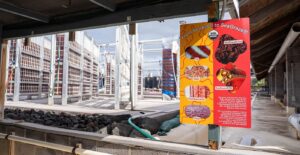The bots are coming for your fields, your food, and your fertilizer.
Three brothers have schemed up an idea that makes John Deere look medieval. In May of 2012, the Bares brothers established Rowbots, a company aimed at reducing the waste of nitrogen fertilizer. As the largest non-seed cost of corn farming—priced at a whopping $8.4 billion per year—much of the nitrogen fertilizer currently used in the U.S. is lost to the air and water, causing inefficient financial costs for the farmer and pollution costs for the rest of us. The Bares think their Rowbots will cut the unnecessary waste and increase yields row by row, bot by bot.
 “The long standing belief in agriculture is that bigger is better,” said Kent Cavender-Bares, CEO of Rowbots. With a B.S. in Ag engineering from Cornell, an M.S. in environmental engineering from Stanford, and a Ph.D. in environmental engineering from MIT, Cavender-Bares know more than just the first thing about finding workable environmental solutions. “We’re going completely out of the box with a small solution. In order for this to work, the Rowbots have to be completely autonomous. They have to keep out of trouble and that’s really new territory.”
“The long standing belief in agriculture is that bigger is better,” said Kent Cavender-Bares, CEO of Rowbots. With a B.S. in Ag engineering from Cornell, an M.S. in environmental engineering from Stanford, and a Ph.D. in environmental engineering from MIT, Cavender-Bares know more than just the first thing about finding workable environmental solutions. “We’re going completely out of the box with a small solution. In order for this to work, the Rowbots have to be completely autonomous. They have to keep out of trouble and that’s really new territory.”
Using a fleet of 20 or more bots, Rowbots distribute nitrogen directly to the crop. The bots are designed to avoid obstacles and are small enough to fit between rows of corn, deviating from the industry norm of using massive equipment for fertilizer.
“The grand vision here is that we’re going to market the service,” said Cavender-Bares. In short, the Bares brothers want to have Robots as a service, or RaaS as the cool kids call it, and they aim to have enough bots to be able to equate to one of the large machines now being used. “We have to have a fleet of small robotic vehicles and there was no comparable machine before…. Long term, a fleet might be 20 or more, with that managed by several personnel across several fields at the same time.”
 Cavender-Bares said by using the bots farmers will not only save on fertilizer costs, but also will also increase crop yields. “The good news is that there’s widespread understanding that those growers who apply nitrogen during the season will save at least 10 percent of their nitrogen,” said Cavender-Bares. “The real big upside is that they then have their fingers on the dial. That should enable them to increase their yields.”
Cavender-Bares said by using the bots farmers will not only save on fertilizer costs, but also will also increase crop yields. “The good news is that there’s widespread understanding that those growers who apply nitrogen during the season will save at least 10 percent of their nitrogen,” said Cavender-Bares. “The real big upside is that they then have their fingers on the dial. That should enable them to increase their yields.”
The idea started back in 2012, on a farm close to the Chesapeake Bay. Dairy farmer, Charlie Bares, who has a B.S. in animal science from Cornell, quickly became familiar with threat of nitrogen regulation and inefficient application. With about 2000 acres of corn farming, Bares learned the downsides of nitrogen loss in corn farming on a massive scale. Thus, the idea of Rowbots was born.
The third brother, John Bares, completed the Rowbot trifecta. With a B.S., M.S., and Ph.D. in civil engineering all from Carnegie Mellon University, John is the CEO Carnegie Robotics, a company specializing in field robotics, and he provides a unique advantage to bring the idea of Rowbots to life.
“We’re in a special position as a startup because we have such a strong connection,” said Kent. “This is not a family business, but rather a company with a nice founding story that is aiming bigger.”




